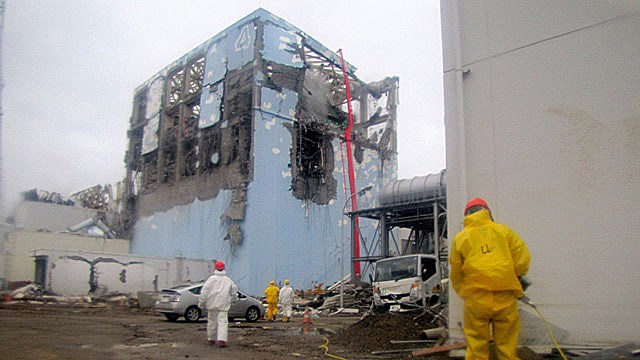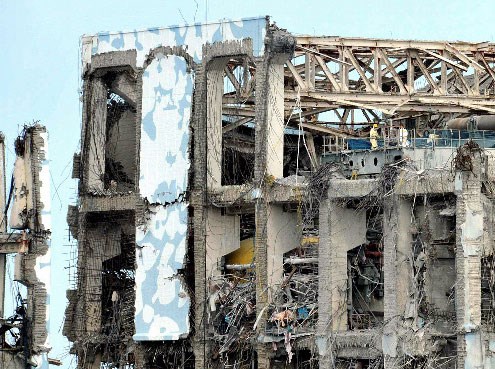Fukushima: Silenced Truth
by Thierry Ribault
Thierry Ribault is a French economist doing research in Japan for the Centre National de la Recherche Scientifique (CNRS) of France, working on the modalities of the protection of humans in the context of the Fukushima disaster. He published an article in Rue 89-le Nouvel Observateur, an Internet magazine, in which he seeks to keenly dissociate himself from a presentation made by his employer, the CNRS, about the nuclear industry and destined to the "broader public," and which he accuses to silence the true situation at Fukushima.
In this "scientific" presentation, statements devoid of argumentation and taking the allure of indisputable evidence accumulate. For instance, it is certified that:
"Nuclear energy is a political investment over the very long term, imposing decisions covering many decades, which it is hard to put in question, even after a major nuclear accident such as the one at Fukushima."
We also learn that:
"The report on the Chernobyl catastrophe made by the World Health Organization (WHO) and the International Atomic Energy Agency (IAEA), published in 2005 under the auspices of the United Nations, evaluated the number of death among immediate victims of the accident to less than 50, and to 2,200 the number of deaths in excess caused by the exposure to radioactivity of the 200,000 most exposed ‘liquidators.'"
Let's us remind ourselves that these estimates have been contested by the Union of Concerned Scientists (which announces 25,000 deaths), and by the New York Academy of Sciences (which announces between 211,000 and 245,000 deaths, 15 years after the catastrophe).
In Ukraine, a government report states that 2,254,471 persons have been affected by Chernobyl, among them 489,409 children. Between 1992 and 2009, among Ukrainian children, the incidence of endocrinian illnesses has been multiplied by 11.6, pathologies of the musculoskeletal (locomotor) system have been multiplied by 5.3, illnesses of the gastro-intestinal system by 5, cardiovascular diseases by 3.7 and troubles of the uro-genital system by 3.6.
The percentage of children presenting chronical illnesses has gone up from 21% to 78%, and of the 13,136 children born to the Chernobyl "liquidators" of 1986-1987, 10% evidenced congenital malformation at birth. (...)
At Fukushima, according to the [French] report, "a red zone of a 20km radius has been delimitated, within which the government is carrying out depollution work: nobody knows when the 110,000 inhbitants will be allowed to return home" - but it does not mention the vast uninhabitable areas reaching to a distance of 40km from the plant, and far beyond, and it does not mention that the criterium defining the zone of compulsory migration has been set at a dose of 20 millisieverts par annum, that is 4 times more than that at Chernobyl and twenty times the internationally admitted norm of inacceptibility.
The famous "non-imposition of values" evoked by Max Weber in his 1917 conference, "Science, a profession and a calling" (which is so well liked by some CNRS researcher, to which they keep referring) was clearly not a consideration in the elaboration of this report on nuclear energy, which seems rather destined, as Weber himself would have put it, to "domesticate the masses."
What the CNRS report should have established concerning the catastrophe at Fukushima, and which its academic executants have chosen not to say, I wish to express now after almost two years of work on the spot.
The Fukushima disaster means a diffusion of Cesium 137 in the atmosphere that was 500 times greater than that at Hiroshima, according to a founding Japanese nuclear physicist Anzai Ikuro. It also means, according to the Norwegian Institute of Air Research, the highest emission of the rare gaz Xenon 133 known outside of nuclear tests: more than twice the emission of Xenon 133 that occurred at Chernobyl. It means today, according to TEPCO, an activity of some 10 million becquerels released every hour from the Fukushima Daiichi source.
It means that one third of the department of Fukushima has been contaminated at a rate superior to 37,000 becquerels per square meter (counting only the Cesium 137) and that at least thirteen further departments have been contaminated, representing some 8% to 10% of the territory of Japan.
It means 1,532 rods of fuel weighing 3 tons each and measuring 4 meters in length, piled in the pool of reactor #4, on the fifth floor of a building which threatens to collapse at the first seismic tremor, eliciting this laconic comment from Prof. Hiroaki Koidea specialist of nuclear reactors from the University of Kyoto: "It would be the end."*
On January 4, 2013, Prof. Koide admitted, in an interview with us, that there still existed "a margin of action for, according to TEPCO, if the pool of the 4th reactor came to collapse, or even if all the cooling water escaped, so long as the disposition of the rods did not get modified, temperature may still rise as high as 170°."
The Fukushima disaster means 24,000 employees having worked on the site since March 2011, of which only 3.7% are eligible to benefit of a cancer detection test proposed by the authority and by TEPCO. It means also that, of the two million inhabitants of the department, only 100,000 nuclear refugees have migrated inside the department, and 63,000 more have moved outside it.
It means that only 10% of the children of the department have been moved outside the department. It means that one third of the 300,000 inhabitants of the city of Fukushima say that they want to leave but cannot do so. It means that the authorities are putting in place an aid to return, in order to incite refugees to come back to zones which are still identified as contaminated, and since Decembre 2012, free public housing for new refugees moving outside the department has been abolished.
The Fukushima disaster means the implementation of the greatest ever conceived public survey on the effects of radiations, which will allow to collect, beginning in 2014 and over thirty years, data relative to the inhabitants of the department, among them 360,000 children, with the stated goal of the team in charge being to "quiet down the fears of the population" and to "establish a scientific record."
There's also this inhabitant of the city of Fukushima telling us in an interview, in November 2012, that the Warsaw ghetto and the contaminated areas of Fukushima are the same thing: "The people outside know that it's the antechamber of death, but they turn away their gaze and continue saying that nuclear energy, one can't do without..."

Reactor #4 at Fukushima
Such is the "protection" implemented in Fukushima which elicits nothing but silence in the CNRS report. "Ignorance is strength," Orwell said. In this situation of the collapse of human conscience, of an inversion where disaster is denied in its negative consequences, only to be transmuted into a business opportunity in a morbid environment where everyone is made to submit, simply taking a position in favor of life has become tantamount to a revolutionary program.
To shorten the period of nocivity of the managers of the organization of appearances, to put into question the interests governing the degradation of the whole, to deceive the deceivers, to topple the invertors of meaning, to evacuate the evacuators: that's what, in my eyes, a researcher at the CNRS should "search" to do.
Not to be content with an engagement, which is but a paltry variant of putting oneself at the service of the nuclear industry, such as demonstrated here by barracks scientists, but, facing the unreasonable actions of the producers of ignorance and the dehumanization which they promote, to show true enragement.
Thierry Thibault
Researcher at CNRS
PhD in Applied Economics, University of Lille

The exposed pool of spent fuel rods on top of reactor building #4
* this Youtube video is available only with French subtitles. Another version with an english transcript has been removed for copyright violations. There exist Youtube videos of conferences of Prof. Hiroaki Koide at U. of Chicago, Berkeley, NYC etc.
For the medical implications of "Chernobyl, Fukushima and the nuclear age," see this video of Helen Caldicott MD, at University of Wisconsin, April 19, 2012. About Fukushima, go to min. 38. Much recommended.
In the wake of the Fukushima disaster on March 11th, 2011, Chancellor Angela Merkel, a chemical physicist by profession with a Dr. rer. nat. (University of Leipzig, 1986, summa cum laude) took the decision to stop eight nuclear plants in Germany and initiated a gradual, full exit of Germany from nuclear energy by 2022. A wise decision, for more reasons than one...

